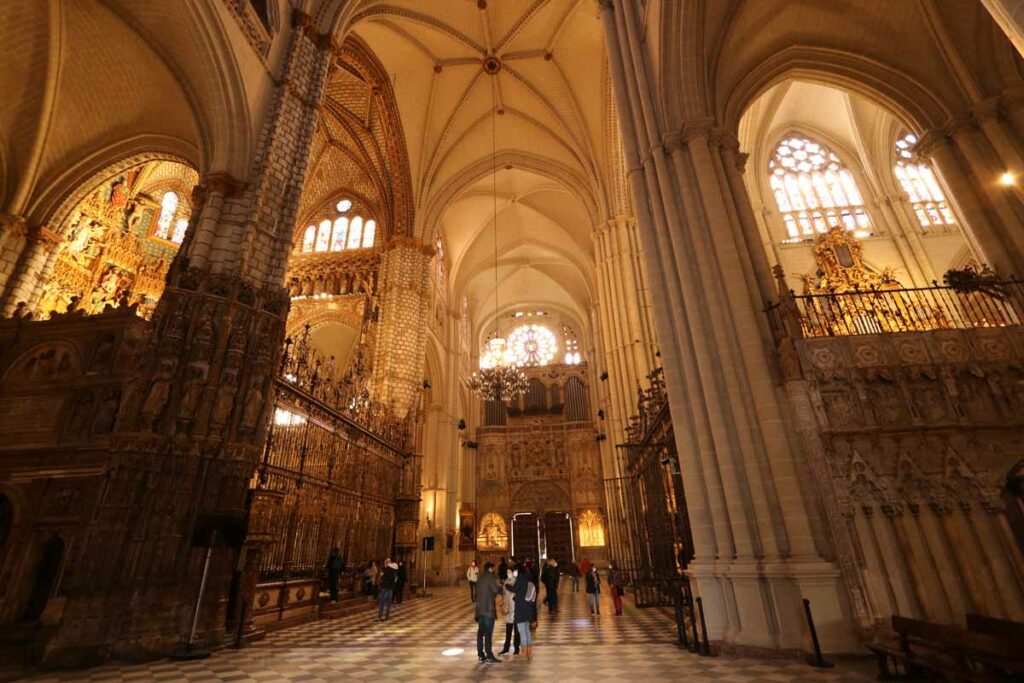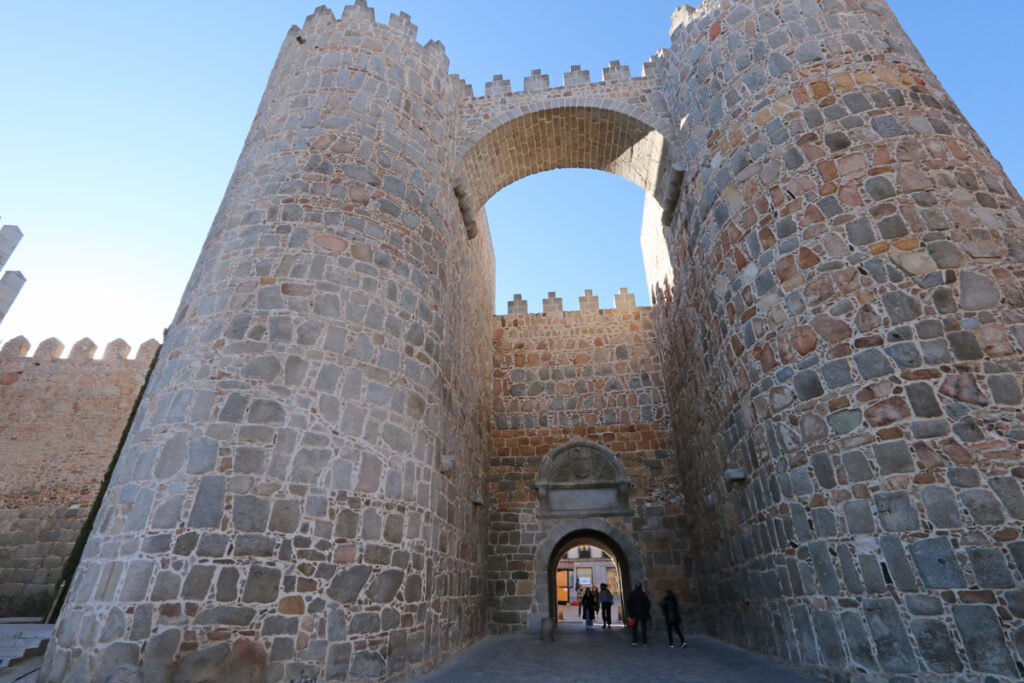The 5 Best Daytrips from Madrid
One of the best things about Madrid is its proximity to some of Spain’s most beautiful and historic towns. In fact, some of them are at the top of my list of favorite towns/cities in ALL of Spain.
Below I list 5 great day trips from Madrid. All 5 are UNESCO World Heritage Sites and most are within an hour of Madrid by public transport.
*A couple of the places I list below deserve much more than a day. But if a day is all you have, you can at least see the main highlights. I’ll tell you what you should prioritize below.
Toledo
Why visit: Toledo is one of Spain’s most famous cities, dating back to the Romans (around 192 BC). After the Romans, it was ruled by the Visigoths and then the Moors before the Christians took it over in 1085 during the Reconquista. It was capital of the Spanish Empire until the 1500’s when the Royal court moved to Madrid. Tons of history from different stages of history and tons of great sights to see.
Getting there: Toledo is super easy to get to from Madrid. We took a train from Atocha station which takes about 30 minutes. Renfe has trains doing the Madrid – Toledo route roughly every hour costing 11 Euros. Once in Toledo, you can take a bus (20 minutes) or taxi to Plaza Zocodover in the center.
Time needed: There is lots to see in Toledo and really it warrants more than a daytrip. I’d stay a night. If so I recommend staying in Barrio Rey Hotel (right next to Plaza Zocodover and really good value).

What to see in a day in Toledo
Toledo has a lot to see so if you’re making this a daytrip I advise that you start early.
Santa Iglesia Catedral Primada de Toledo. Start your visit here. It’s one of the most impressive Cathedrals in all of Spain as well as one of the oldest. Huge (120 meters long, 45 meters high), lined with 750 stained glass windows and with a large skylight (called “el transparente”) cut into the back wall of the altar. Incredibly impressive.
Note: the Cathedral is FREE between 8 and 9:30am Monday to Friday (otherwise it costs 12 Euros per person). My post with photos/video on Toledo Cathedral. The Cathedral is less than 10 minutes walk from Plaza Zocodover along Calle del Comercio. If coming for the free time between 8 – 9:30, you have to enter the side entrance.

Monasterio de San Juan de los Reyes. This Gothic monastery was built in the 15th century to commemorate the political victory of the Catholic monarchs which led to Isabella I taking the throne of Castile. The monastery has a stunning church with incredible ornate reliefs on the side walls. It also has lower and upper cloisters overlooking a small garden in the middle.
Note: when coming to the Monastery, buy the Tourist Bracelet (Pulsera Turistica). It lets you see 7 great highlights in Toledo (including most that I cover here) for a total of 12 Euros. If just visiting the Monastery you would pay 4 Euros but you wouldn’t see all the other sites.
Puente San Martin. One of Toledo’s famous bridges, it is a 5-minute walk from the Monasterio de San Juan de los Reyes. It was built in the 14th century to connect Toledo to the western side of the Tagus river. FREE. The bridge is beautiful and you have great views of the river and the monastery up the hill.

Walking back, you should visit the sites covered by the Tourist Bracelet: Sinagoga de Santa María La Blanca, Iglesia del Salvador, El entierro del Senor de Orgaz, Iglesia de los Jesuitas (for some of the best views of Toledo), Ermita “Mezquita” del Cristo de la Luz.
At the Ermita “Mezquita” del Cristo de la Luz, you’ll notice the views of the city facing the north and will no doubt notice the huge city gates below. Those are the Puerta del Sol (right next to the Mezquita) and the Puerta de Bisagra. It’s worth walking down the hill and seeing them.

You’ve probably seen this photo (above) of Toledo. It is taken from Toledo’s Parador and is the most famous view of Toledo. We stayed here a night. But you can come here and have a coffee on the terrace, it’s what a lot of people do (note that there’s no easy way of getting to the Parador. If you don’t have a car you’ll have to take a taxi).
I cover Toledo in more detail in this post. Note: Toledo is famous for its marzipan. So if coming here make sure to head towards the Jewish quarter to get some marzipan (close to the church of Santo Tomé, on Calle de Santo Tomé, you’ll find a few shops making their own marzipan)
Segovia
We loved Segovia, a hilltop town with a blend of history and an incredible geographic location. It is also home to 3 of Spain’s famous attractions.
Why visit: Even before the Romans came, the Celtics had a settlement here. But it was after the Christians took Toledo and resettled in the region that Segovia became wealthy due to its position on important trade routes. Between the 12th and the 15th centuries, several of the kings of Castile resided in Segovia. Queen Isabella was crowned there in 1474. Besides the history, the town looks like it came out of a fairytale with its hilltop Alcázar (castle/fortress) and snow-topped mountains as a backdrop.
Getting there: The easiest, fastest and cheapest way to get to Segovia from Madrid is by Avanza bus. Buses leave from the Moncloa bus station, cost about 5 Euros (one way) and take approximately 1 hour to get to Segovia.
Time needed: It’s easy to see the highlights of Segovia in a day. But just walking around, enjoying the views and walking the small streets is a joy in Segovia. We stayed 2 nights and wished we had stayed longer (recommended: the Infanta Isabel. Excellent hotel, good rates and perfect location on Plaza Mayor (across from the Cathedral).

What to see in a day in Segovia
There are 3 main things you can’t miss in Segovia.
The Roman Aqueduct. Built by the Romans in the first century AD, it carried water from the Guadarrama Mountains to the center of town (a distance of 15 km). The most visibly impressive part of the aqueduct is the Aqueduct Bridge which spans almost 30 meters above Plaza Azoguejo, one of the town’s main squares. You can climb the steps up the Postigo Del Consuelo and from there have great views of the aqueduct and the mountains in the distance that were the source of the water.
The Alcázar. This castle was built in the mid-1400’s and later also served as a royal palace, becoming the primary residence of the monarchs of Castile.
The Alcázar is incredible. From the outside it looks like a fairy castle out of a Disney movie. Inside, the halls and rooms (I counted 9) have a mix of Christian and Mudéjar (Moorish) aspects including azulejos, carved arches and incredibly decorated ceilings (the ceilings are among the most impressive we have seen). More here on the Alcázar.

Cathedral of Segovia. Considered one of Spain’s top Cathedals, it was built between 1525 and 1577 and is considered to be the last Gothic building in Spain. It is a huge, spacious and elegant Cathedral with high columns and ornate ceiling beams.
Other things to see/do: Torreón de Lozoya: A palace with a tower on plaza de San Martín. The best views of Segovia in my opinion as well as a museum with local art. Walls of Segovia: You can walk along some of the walls of Segovia. There is a tourist information point at Plaza del Socorro where you can buy your tickets.
More on Segovia here. The local specialty here Roast Suckling Pig (Cochinillo).
Ávila
Why visit: Ávila is known for its Medieval walls, the most complete medieval walls in Spain (they surround the whole of Old Town). It makes sense because Ávila was always a frontier town and under Moorish rule was repeatedly invaded by the Christians. Finally, in 1088, the Moors were defeated. Ávila is also known for its religiosity: Ávila’s most famous period came in the 16th century when Santa Teresa de Jesús (a noblewoman turned nun) became famous. It made Ávila an important pilgrimage destination.
Getting there: The best way is by train – it takes 1 ½ hrs to get to Ávila from Madrid’s Principe Pio station (which is downtown) or Chamartin station.
Time needed: You can easily do Ávila in a day, it’s not a big place.

What to see in a day in Ávila
The Walls of Ávila. They circle the town (a total of 2.5 km) with an average height of 12 meters. They are massive and very impressive. You can circle the walls (make sure to stop at Mirador de los Cuatro Postes to see the city and walls from afar) and walk atop the walls.

Ávila Cathedral. It’s Spain’s oldest Gothic Cathedral (started in 1088…completed in the 14th century). It makes up part of the walls of the city and walking inside it really feels like a place of kings and knights. It’s one of my favorite Cathedrals in Spain. More on Ávila Cathedral.
Other sites of Interest: Convento de Santa Teresa de Jesús and Basilica de San Vicente. Ávila claims to have the highest number of churches per capita in Spain.
More on Ávila. The speciality here are Yemas de Santa Teresa, an egg-tasting dessert. We didn’t like it. But you can buy it anywhere in Ávila and should at least try it out.
El Escorial
Why visit: El Escorial is a huge royal complex. Built in the mid-1500’s, it is the largest Renaissance building in the world and functions as a monastery, basilica, royal palace, pantheon, library, museum, university, school, and hospital. It has been the burial site for most of the Spanish kings over the last 500 years.
Getting there: The best way is to take the train (C-3a) from stations Madrid Puerta de Atocha. The trip takes an hour and costs about €7 each way. From the train station, you have to walk about 20 minutes to get to the complex.
Time needed: 3 to 4hours is enough for most people. It’s a huge site but much of it isn’t open to the public.

What to see in El Escorial
Highlights of El Escorial include:
The Royal Pantheon (a basement of marble tombs and crypts)
The Hall of Battles (a depiction of Spanish military victories from the 15th and 16th centuries on huge frescos)
The Royal Library (a beautiful library with colourful overhead frescos)
The Basilica of San Lorenzo (decorated with marble, woodwork and lots of stained glass)
The Garden of the Friars (the large gardens of the complex)
Note: they are very fussy about photos at El Escorial (no inside photos. So be prepared…)
Alcalá de Henares
Why visit: Alcalá de Henares was the birthplace of Miguel de Cervantes – the most famous writer in the Spanish-speaking world. The city is also famous for its university which dates back to 1499, one of Spain’s oldest universities. This is still a university town and you’ll see lots of students including many international students.
Getting there: There are regular trains (up to 3 an hour) from Madrid’s Atocha station to Alcalá de Henares. Getting there takes 40 minutes. The train station is an easy walk to the old town.
Time needed: There’s plenty to see in Alcalá de Henares but the highlights can all be seen in a day.

What to see in Alcalá de Henares
The College of San Ildefonso is the main building of the University of Alcala (also called Universidad Complutense). It is considered one of Spain’s finest renaissance buildings and you can take a tour which includes taking in the white marble tomb of Cardinal Cisneros (the founder of the University) and the intricate woodwork on the ceilings. If there is one thing you have to see in Alcalá de Henares it is the College of San Ildefonso.
Museo Casa Natal de Cervantes. It was the family home of Miguel de Cervantes and the museum (which is free) gives you a taste of life at the time (he was born in 1547, he died in 1616). It’s not a big museum – but is very well restored with old pieces of furniture and artifacts which gives you a picture of the world Cervantes lived in as a child.
Besides the above, you should wander around and see Cervantes Square (an old medieval square, subsequently named after him), Corral de Comedias (an impressive building with an outdoor theatre set up in the inner patio), Santos Niños Square, the Gate of Madrid (one of the gates to the old city) and the Archbishop’s Palace. Alcalá de Henares is a pretty city to wander around in.
What’s your favorite daytrip from Madrid?
Related: Visiting the beautiful city of Burgos

Related: Should you visit Salamanca?

Related: 48 Hours in Madrid (and why I liked the city more than I thought I would…)


Leave a Reply